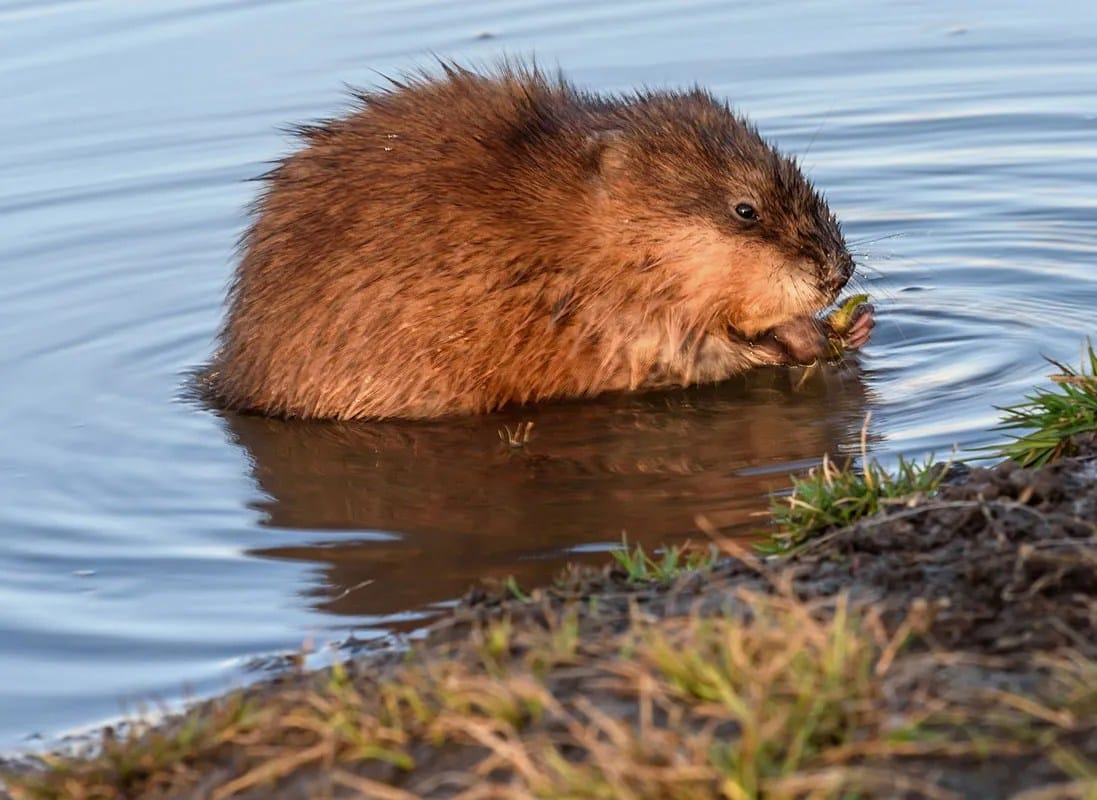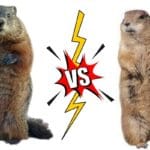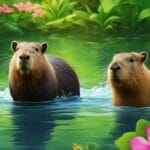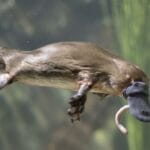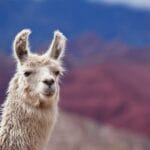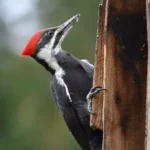Muskrats, often mistaken for their larger beaver cousins, are fascinating creatures that make their homes in North America’s wetlands. They’re like tiny architects, shaping their surroundings to create a cozy life for themselves. Let’s get up close with these furry friends and learn how to tell them apart from beavers.
## A Peek into the Secret Lives of Nature’s Wetland Architects
Ever heard of a muskrat? They’re like the master builders of North America’s wetlands – the busiest rodents around! Muskrat pictures give us a backstage pass to their watery world, showing us just how cool and important these often-overlooked creatures really are.
One look at a muskrat picture, and you’ll see why they’re perfectly suited for life in the water. Their fur is like a waterproof coat, and their big, webbed back feet are practically made for swimming. They even have this neat trick where they can close their lips behind their teeth, allowing them to gnaw on plants underwater without getting a mouthful! Talk about amazing adaptations!
But muskrat pictures reveal so much more than just their looks. These pictures tell stories of incredible work ethic. Muskrats are like the ultimate homebodies, building elaborate lodges out of cattails, reeds, and mud. These aren’t just any old shelters, though. They have underwater entrances, cozy chambers, and everything a muskrat family could need to survive. It’s like something out of a nature documentary, but it’s all real!
And speaking of families, muskrat pictures often capture their playful side. You might see a mother muskrat swimming with her babies clinging to her back, or a group of youngsters wrestling in the water. It’s a reminder that these animals are more than just “rodents”—they have social lives, families, and personalities just like we do.
However, muskrat pictures aren’t just about cute moments. They also serve as a stark reminder that these amazing creatures face some serious threats. As humans continue to destroy wetlands for development, muskrats are losing their homes. Pollution and trapping also take a toll on their populations. Looking at a muskrat picture, we’re forced to confront the reality of their situation and ask ourselves what we can do to help.
Ultimately, muskrat pictures offer us a glimpse into a world that’s both beautiful and fragile. They remind us that even the smallest creatures can play a vital role in the balance of nature. So, the next time you see a muskrat picture, take a moment to appreciate the ingenuity of these wetland architects and consider how we can all do our part to protect them and their wetland homes.
## How to Identify a Muskrat
Okay, so you’re out and about near a pond or river, and you spot something moving. Could it be a muskrat? These little critters can sometimes be mistaken for other animals, but don’t worry, we’ll get you up to speed on their telltale signs!
First things first, size. Muskrats are like the medium-sized rodents of the wetland world – not as tiny as a mouse, but definitely not as big as a beaver. Imagine a furry football with legs, and you’re pretty close. They usually clock in around 13 inches long, not counting their tail, and can weigh up to 4 pounds.
Speaking of that tail, that’s your biggest clue! It’s long, about the same length as their body, but here’s the kicker: it’s flattened vertically and scaly, almost like a rudder. Now, this is where people get tricked – beavers also have big tails, but theirs are flat horizontally. So, think vertical = muskrat, horizontal = beaver.
Next, check out their fur coat. It’s a practical, no-nonsense kind of deal – thick, waterproof, and usually a dark brown color. This helps them stay warm and dry while they’re swimming around.
Their little faces are pretty cute too. They have small, beady eyes and even smaller ears that are almost completely hidden by their fur. You might not always see them right away, but they’re there!
And finally, take a peek at their back feet if you can. You’ll notice they’re webbed, just like a duck’s! This is what makes them such strong swimmers.
So, to recap: If you see a chunky rodent with a long, vertically flattened tail, dark brown fur, and webbed feet hanging out near water, chances are you’ve found yourself a muskrat. Happy wildlife spotting!
## A Closer Look at the Muskrat
So, we’ve established that muskrats are pretty amazing architects, but what else makes them so unique? These semi-aquatic rodents are known for their ability to thrive in wetland environments. They can weigh up to four pounds and grow to about 13 inches long, not including their impressive tail, which can be just as long as their body. But here’s the catch – their tail isn’t furry and cute like a squirrel’s. It’s actually flat, hairless, and covered in scales. This unusual tail acts like a rudder, helping them navigate the watery world they call home.
Muskrats are perfectly adapted for a semi-aquatic lifestyle. Their fur isn’t just any ordinary fur; it’s thick, dense, and completely waterproof. This keeps them warm and toasty even when they’re swimming in chilly water. And check out their back feet – they’re webbed, just like a duck’s! This makes them incredibly strong swimmers, able to hold their breath for up to 15 minutes!
But their impact on the environment goes far beyond just swimming around. These little guys are like the engineers of the wetlands, their feeding habits and lodge-building activities shaping the entire ecosystem. Think of them as natural landscapers, influencing which plants thrive and how water flows through the wetlands.
Muskrats are primarily vegetarians, with a particular fondness for cattails and bulrushes. Imagine them munching away on these wetland plants, much like a beaver gnawing on a tree. But hey, even vegetarians need a little variety, right? So, they’ve been known to snack on the occasional invertebrate, amphibian, or even a small fish if they’re lucky enough to catch one.
The muskrat’s resourcefulness doesn’t end with their diet. Their homes are architectural marvels in their own right. They construct elaborate lodges out of vegetation, strategically placed in shallow water. The real genius lies in the entrance – it’s underwater! This clever design provides protection from predators and keeps their living quarters safe and dry.
Scientists are constantly learning more about muskrats and their role in the complex web of life. There’s still much to discover about their behavior, social interactions, and how they adapt to changing environments. What we do know is that these fascinating creatures play a vital role in maintaining the health and balance of our wetlands.
## Muskrat vs Beaver: What’s the Difference?
Okay, so you’re out for a stroll by the river and you spot a furry critter paddling around. You think, “Hmm, is that a muskrat or a beaver?” It’s an understandable question! These two wetland-loving rodents share some similarities, but understanding their differences can help you quickly tell them apart.
First things first, size matters. Beavers are like the heavyweights of the rodent world, significantly larger and heavier than muskrats. Think of it this way, if you saw a muskrat next to a beaver, the beaver might be mistaken for the muskrat’s bigger, stronger cousin.
But the real giveaway is in the tail. Forget the fluffy, cartoon-like tails; a beaver’s tail is broad, flat, and scaly, resembling a paddle. This unique tail isn’t just for show, it helps them maneuver through the water with surprising grace and power. Meanwhile, muskrats have longer, thinner tails that are flattened vertically, kind of like a rudder.
Then there’s their choice of real estate. Muskrats are a bit more adaptable, making their homes in various wetland habitats, even those without much flowing water. They build smaller lodges mainly for shelter and raising their young. Beavers, however, are true architects, preferring areas with trees and flowing water. They construct elaborate dams and lodges, significantly transforming their surroundings and creating thriving wetland ecosystems.
Speaking of ecosystems, both muskrats and beavers play important roles. Muskrats help keep vegetation in check and contribute to nutrient cycling. Meanwhile, beavers are considered a keystone species. Their dam-building prowess creates wetlands that support a diverse range of plants and animals, making them essential for a healthy ecosystem.
So, the next time you’re near a wetland, remember these key differences. The hefty builder with the paddle-like tail is likely a beaver, while the smaller, more adaptable resident with a long, thin tail is probably a muskrat. Both are fascinating creatures that add to the richness and biodiversity of our wetlands.
There are several different species of water rodents you may encounter at some point, like the [northern cottonmouth](https://www.lolaapp.com/northern-cottonmouth) and the [nutria vs capybara](https://www.lolaapp.com/nutria-vs-capybara).
- Georgia Platform: A Southern Strategy, 1850s - March 31, 2025
- How many weeks is 40 days: Quick Conversion Guide for Accurate Results - March 31, 2025
- How many feet is 300 meters? 984 Feet: Understand Length Conversions Easily - March 31, 2025
